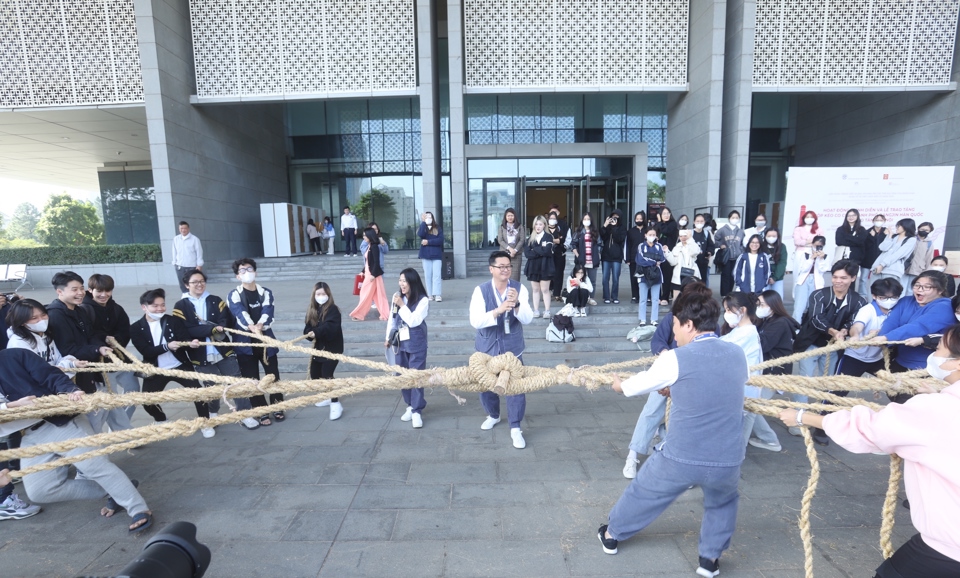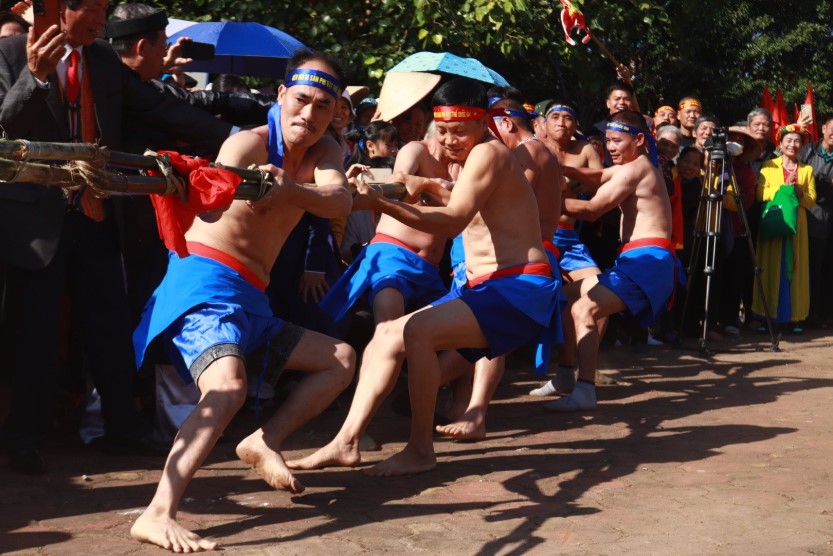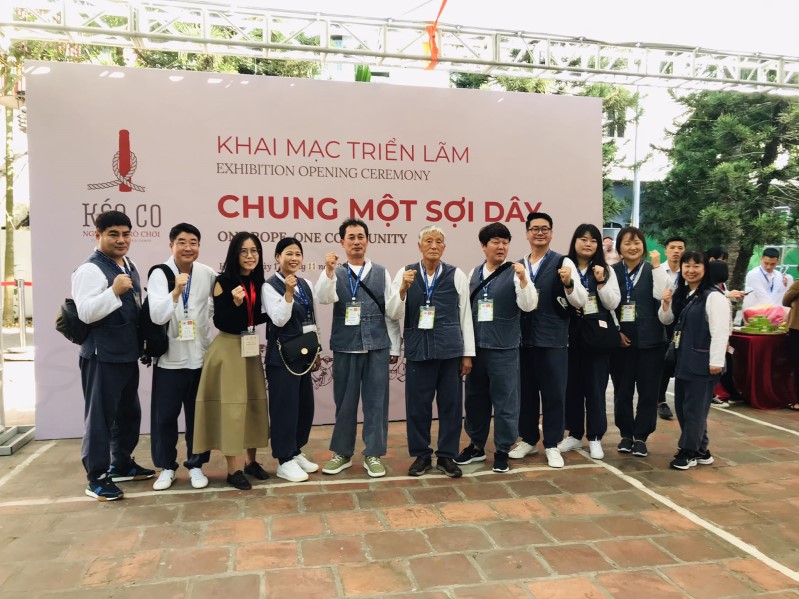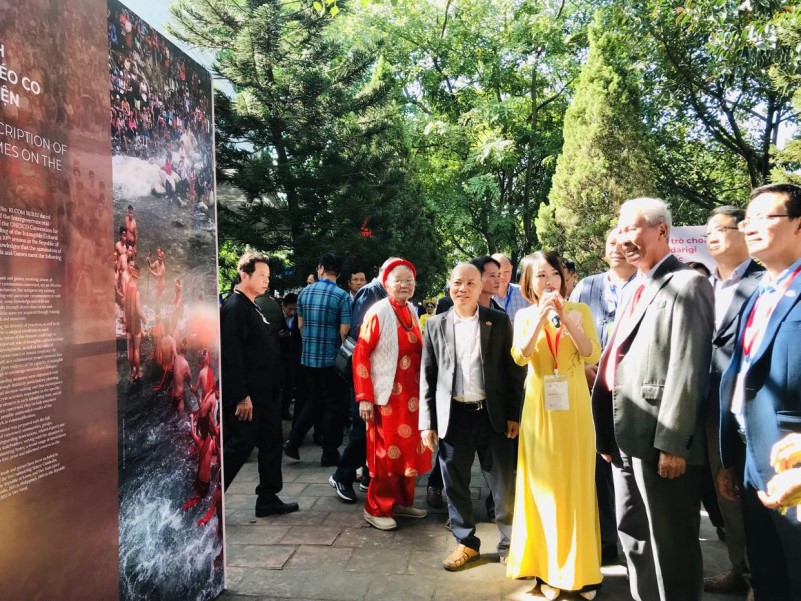Vietnamese-Korean tug-of-war competion celebrates Hanoi as creative city
The Festival of Tug-of-War Rituals and Games was held with eight teams from Vietnam and South Korea as part of the Hanoi Creative Design Festival.
The Festival of Tug-of-War Rituals and Games was held on November 17-18 at the Hanoi Museum and Tran Vu Temple in Long Bien District, Hanoi, with the participation of nearly 500 artisans from the provinces of Bac Ninh, Lao Cai, Vinh Phuc, Hanoi and Dangjin City (Chungcheongnam-do, South Korea).
Titled "One Rope, One Community", the festival, the first of its kind held in Vietnam, aimed to strengthen ties and exchanges among communities practicing tug-of-war, a UNESCO-recognized heritage.
On November 17, a discussion on tug-of-war heritage education was held at the Hanoi Museum with 50 delegates from the Gijisi Tug-of-War Association (Dangjin City, Korea) and Vietnamese experts.
| Demonstration of the South Korean tug-of-war team at the Hanoi Museum. Photo: Lai Tan/The Hanoi Times |
The discussion aimed to exchange experiences in organizing tug-of-war rituals and games, as well as protecting cultural heritage.
At the event, the Gijisi Tug-of-War Museum presented the Tug-of-War Education Box to the Hanoi Museum and performed a demonstration of the Korean Gijisi Tug-of-War Game and Ritual.
According to Jeong Seok Yong, Secretary of the Gijisi Tug of War Association, the tug-of-war rope used in the Hanoi performance is 200 meters long. One part of the rope represents the upper village (area with water) and the other part represents the lower village (area without water). The ropes are made of straw. During festivals in Dangjin City, thousands of people pull ropes weighing up to 40 tons.
| The festival was joined by nearly 500 artisans from the provinces of Bac Ninh, Lao Cai, Vinh Phuc, Hanoi and Dangjin city (Chungcheongnam-do, South Korea). Photo: Hanoimoi.vn |
On November 18, an international discussion on "Protecting and Promoting Tug-of-War Rituals and Games in Contemporary Life" was also held at Tran Vu Temple.
People witnessed tug-of-war games performed by the Gijisi Tug-of-War Association (Dangjin City, Korea) and seven tug-of-war teams in Vietnam.
Ngo Quang Khai, representative of the sitting tug-of-war team at Tran Vu Temple, Long Bien, Hanoi, said: "At present, we are doing a good job in preserving the heritage, especially in introducing it to the young generation. Every year, about 12,000 students come to the temple to learn about sitting tug-of-war. The local government is very interested in preserving the game and is currently supporting the construction of traditional houses to show pictures and documentaries introducing the heritage.
| Gijisi Tug-of-War Association (Dangjin City, Korea) preparing to perform tug-of-war at Tran Vu Temple. |
Legend has it that a long time ago, Ngoc Tri Village suffered a severe drought. Of the 12 wells in the village, only one in a hamlet called Dia had water.
The men from the other two villages, Duong and Cho, went to Dia's well to fetch water but were stopped by Dia's villagers, who forcibly removed the buckets of water and the ropes used to carry them. Fearing the water would spill, they clung to the buckets and were dragged away, sitting down.
After the drought ended, the villagers remembered the hard times by practicing tug-of-war and sitting down at village festivals to pray for good health and a bountiful harvest. They try to pull a 50-meter rattan pole against each other.
Competitors must be physically strong and of good moral standing in the community. Throughout the game, they must sit with one leg outstretched and the other bent to hold the pole firmly under their armpits. If a player stands up, his team loses immediately. Before the game, people gather at the Tran Vu temple to burn incense and pray.
The tug-of-war ritual and game are held during the Tran Vu Temple Festival on the third day of the third lunar month every year to show people's respect for the gods and their desire for a peaceful life.
| Scholars and the public visit an exhibition on tug-of-war. Photo: Hanoimoi.vn |
Professor Do Van Tru, Chairman of the Vietnam Cultural Heritage Association, said tug-of-war is not only a game or sports but also a ritual practiced by communities of all ethnicities throughout the country, each with its own nuance, creating cultural diversity.
"When honored by UNESCO, this heritage does not only belong to a particular community or Vietnam, but is part of the world heritage, so we need to preserve, promote and connect communities in the country, thereby connecting with other countries that also have this heritage," Tru said.
In 2015, tug-of-war rituals and games in Cambodia, the Philippines, Korea, and Vietnam were inscribed by UNESCO on the Representative List of the Intangible Cultural Heritage of Humanity. Vietnam has four localities, including Lao Cai, Vinh Phuc, Bac Ninh, and Hanoi, with registered heritage.















